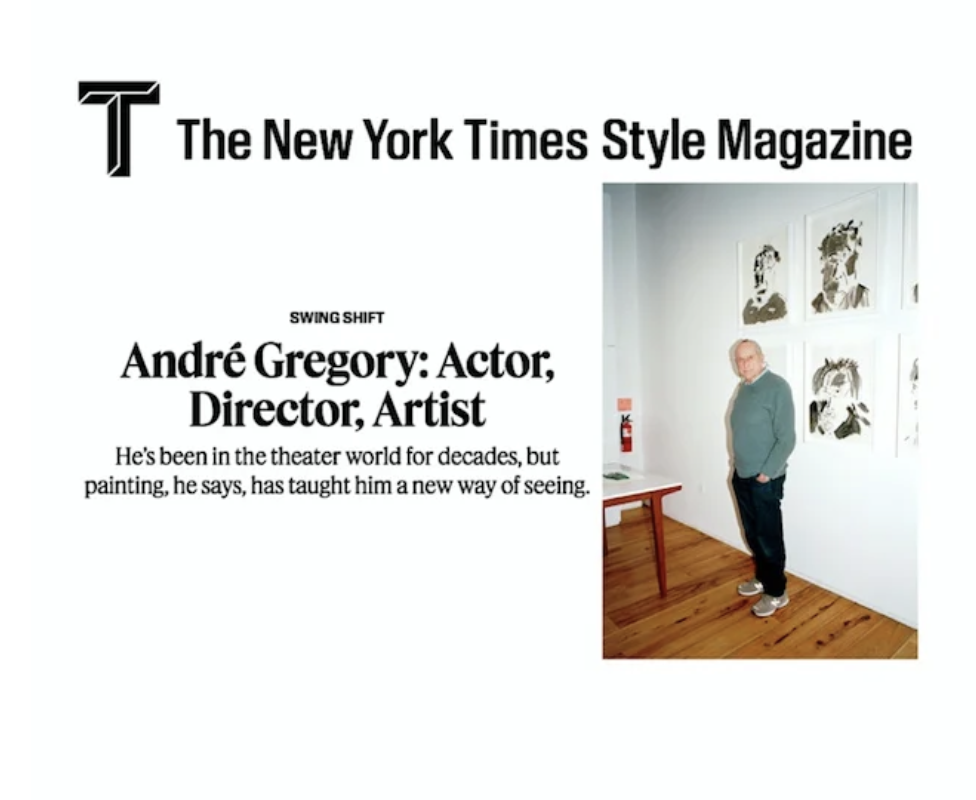T - The New York Times Style Magazine
ANDRÉ GREGORY: ACTOR, DIRECTOR, ARTIST
By Kate Guadagnino
André Gregory, the esteemed theater director, actor and writer, has always been a seeker. In his 20s, he traveled to East Berlin to spend a weekend seeing shows by the Berliner Ensemble — the Marxist theater collective founded in 1949 by the playwright and theorist Bertolt Brecht — and ended up watching the group’s rehearsals for nearly two months. Two decades later, he held experimental movement workshops in a Polish forest and meditated with a Buddhist priest in the Tunisian desert, experiences that were immortalized in the director Louis Malle’s cult film “My Dinner With André” (1981), in which Gregory plays a version of himself: the magnetic, spiritual foil to his friend Wallace Shawn’s earthbound everyman. More recently, up until Covid-19 hit, Gregory, 86, would regularly make his way from his home in Manhattan’s Chelsea neighborhood to the Lower East Side, where he’d climb five flights of stairs to the studio of the artist Jen Mazza, a friend of a friend who has become his current guide in his latest passion: painting.
“I try not to be afraid of the unknown,” says Gregory, who started painting 16 years ago, after his wife, the photographer and filmmaker Cindy Kleine, suggested he take an art class. “When you’re already good at something, to do something you know you’ll be bad at takes chutzpah.” Whereas theater is ephemeral and collaborative, painting is material and solitary, but Gregory goes about them similarly: For him, creating is mostly, as he puts it, mindless. In his dramatic work, this means having no preconceived notions, and instead exploring moments over and over — he workshopped his 2013 film adaptation of Henrik Ibsen’s “The Master Builder” with the director Jonathan Damme for 14 years — to unlock the actor’s unconscious and build texture. His paintings are equally instinctual: “It’s: Look, make a mark, look, make a mark — I’m not sure where it’s going to go.”
As of late, this process has led to vibrant watercolor and acrylic renderings of trees, potted plants and household items (a teakettle, an umbrella stand) as well as gestural self-portraits done in ink, a selection of which will go on view October 10 at Monica King’s TriBeCa gallery. With their slightly blurred edges, Gregory’s everyday subjects seem imbued with the heightened meanings they might take on in a dream. Once, when Gregory was feeling very low, a guru advised him to try to find wonder in something as ordinary as a stoplight turning from red to green; indeed, he now credits painting with teaching him a new way of seeing — when he sits down to paint, he wishes to encounter reality, like a Martian, for the very first time. “The works have the sort of childlike quality you find in Matisse,” King says, “but also evidence of André having become completely obsessed with an object.” The artist, for his part, considers the paintings to be less tortured than his other work — “you better be chasing joy in your later years,” he says. Even so, they are not devoid of what Mazza calls “shadier elements”: One canvas shows a sunlit tree with lime-green leaves; another, a gnarled majestic one, its branches mostly bare.
Gregory believes a painting of a tree might reveal as much about its artist as any other, but then there is his ongoing series of actual self-portraits, which range from sly to stone-faced. Seen side by side, they are testaments to the multiplicity of selves that exist within us all. “Some you show to the world, some you don’t and some you might be horrified to discover,” he says, hinting at a kind of self-knowledge he’s been searching for all this time. “Might this be part of the task of being human: to keep working on oneself?” he asks in his autobiography, “This Is Not My Memoir,” out in November. And yet, he’s not solipsistic. He writes that the André in “My Dinner With André” is “a character who is driven, obsessed and narcissistic, who delights in the sound of his own voice.”
In person, though, he’s a deeply gracious conversationalist, someone who, like Shawn’s character in the film, enjoys “finding out about people” — and his interest extends well beyond those at his own table. His Russian-Jewish parents got him and his younger brother out of France in the fall of 1939, just before the Nazi occupation, and he loathes fascism in all its forms. Painting is a way of providing a balm, to artist and viewer alike, in a calamitous era. “We live in almost Old Testament times, with plagues and insane kings,” says Gregory. “It’s crucial that we look at those things critically but also try to feel hope and joy. The grief isn’t the whole story.”
OCTOBER 2, 2020

